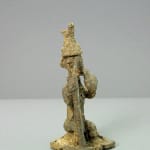Yoruba Metal Alloy Ogboni Sculpture of a Man, 1200 CE - 1600 CE
Metal Alloy
2 x 4.75
PF.4743
Further images
Statuettes, such as this intriguing example, can be interpreted as symbols of established concepts related to religious beliefs. They may also be seen as 'portraits' of actual individuals, or archetypes...
Statuettes, such as this intriguing example, can be interpreted as symbols of established concepts related to religious beliefs. They may also be seen as 'portraits' of actual individuals, or archetypes of familiar figures in society. It's origins are deeply imbedded in Yoruba belief, more deeply than the tomb in which it was found. Like the Phoenix rising from ashes, this statue presents a near primordial figure from a vanished age. Nonetheless, it contains iconographic details that still resonate in Yoruba belief today.
The fact he is seated indicates rank and status in society, suggesting he is a chief or important priest/sorcerer. The staff he holds in his right hand further confirms this supposition. Both the gourd, (held in his left hand) and the bird sitting on his hat are icons related to Yoruba creation myth, and essential elements in oral lore and art. The gourd, as an actual object owned by witchdoctors, may have contained medicinal liquids. In fact, he does appear to be drinking from it; perhaps sampling his own medicine. This proud male seems to be wearing a large ornament on his chest attached to his neck, which may be an emblem of office. As a votive figure this statue contains energy and power. It seems to come from another sphere of existence; with its secrets still alive waiting for new offerings from an enlightened art lover.
The fact he is seated indicates rank and status in society, suggesting he is a chief or important priest/sorcerer. The staff he holds in his right hand further confirms this supposition. Both the gourd, (held in his left hand) and the bird sitting on his hat are icons related to Yoruba creation myth, and essential elements in oral lore and art. The gourd, as an actual object owned by witchdoctors, may have contained medicinal liquids. In fact, he does appear to be drinking from it; perhaps sampling his own medicine. This proud male seems to be wearing a large ornament on his chest attached to his neck, which may be an emblem of office. As a votive figure this statue contains energy and power. It seems to come from another sphere of existence; with its secrets still alive waiting for new offerings from an enlightened art lover.







